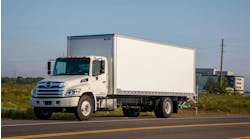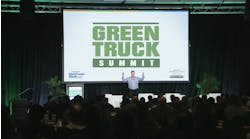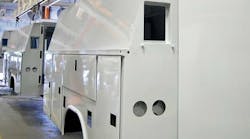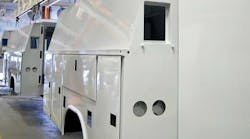IF there were such a thing as Extreme Makeover: Manufacturing Plant Edition, Reading Truck Body wouldn’t have welcomed Ty Pennington and his crew of hundreds to the facility in Reading, Pennsylvania.
There wouldn’t have been camera shots of Pennington on the team bus, saying, “I’m Ty Pennington, and the renovation starts right now!”
And at the end of seven days, there wouldn’t have been any camera shots of Pennington shouting, “Bus driver, move that bus!” as the new plant was finally revealed for the Reading Body family to see the end result of the team’s efforts.
It’s a nice, feel-good concept, but it wouldn’t have been enough for Reading.
For a true transformation, Reading needed more than new machines, a reconfigured plant, the adoption of a lean-management system, a partnership with Monroe Truck Equipment, the addition of new visionary executives, and the development of a platform of diverse new products for different market segments. Reading needed an entirely new mindset that drilled right to the core of a company that was started in 1955 as Reading Body Works Inc by Irving Suknow.
And now, two years after Brian Nadel took over as CEO/president, the results are quite obvious.
“We’re in the absolute top tier in our industry today from a performance standpoint,” Nadel says. “This industry generally runs on slim margins and price sensitivity. However, our new processes and practices allow us to maximize ‘cost-out’ opportunities. The first quarter of 2013 was the best quarter financially this company has had in its history. The last two quarters have remained positive and improved year-over-year, but the first quarter remains our best.”
For most of the past 23 years, the 48-year-old Nadel has been a turnaround expert, most recently at TRW Automotive, Parker Hannifin, and the Dover Corporation. He comes in when things get rough. And things had gotten rough at Reading.
He had two other job offers in December 2011, but he chose Reading because he remembered the iconic logo on the tailgate of truck bodies he had first seen as a boy, he had studied the company’s downfall, and he wanted to be a part of a return to glory.
“For 50 years, it was a founder-family-owned, family-run, operation,” he says. “After that, it grew significantly and was taken over by a private-equity firm. Then the economy collapsed. Reading just kind of lost its way. It was so reliant on tribal knowledge rather than processes.
“When I came in, my four bullet points to the board were, ‘Great products, good people, few systems, no leaders.’ That was as succinct as you could be about Reading. I wanted to bring in talent, but more importantly bring in processes that people could work to. There is an intelligent group here, but for a lot of them, this is the only place they’ve ever worked. This is all they know. When I sat down and talked to them and tried to explain to them, ‘Hey, that’s not how you should do it,’ they said, ‘You should see how we used to do it.’ I went, ‘No, you should see how everyone else does it.’
“It’s a difficult transition in the sense that business skills aren’t supportive. There’s a lot of tribal knowledge. A lot of what I had to rely on is the way they said it was done. And, the data in the system was probably not right, whether it’s bill of materials or whatever. Technologies and processes have changed so much over years, but nobody updated them here. It was really getting things down to a basic level of common sense.”
He says the biggest challenge he faced was that he was just the fourth CEO in the company’s history, and the others had a much different management style. He didn’t just want input. He demanded it.
“The previous three CEOs were very much the sole drivers of the business,” Nadel says. “They would tell you what to do. People did not do anything except react. When I came in and asked, ‘What do you think?’ they said, ‘We’re not saying anything. The last time anybody said anything, they got fired.’ I’m like, ‘Here’s the deal: If you don’t say something, I’m going to fire you. Why would I pay you benefits and salary to just do what I tell you? I can hire a temp and tell them what to do. So let’s work together.’
“So we started recruiting employees by holding lunch-and-learn sessions, telling them what we were trying to accomplish, giving them books on lean to read, and then going through them chapter by chapter in weekly sessions—not to embarrass them, but to make sure they understood, ‘This isn’t negotiable. We’re going to do this, and you’re going to be tested on it.’ ”
It didn’t take him long to realize his hourly workforce was by far the best he had ever had in the 89 worldwide factories he had run in his career.
In most of the turnarounds, the response to his invitation for input usually went something like this: “The candy bars in the machine are stale.” At Reading, he received specific suggestions on how to save scrap or which press brakes would help production.
“You dream of hearing that in a turnaround,” he says.
Having worked in the automotive industry and having focused on turnarounds for so long, he became a passionate proponent of lean-management principles. He said Reading, like a lot of companies, had attempted it, but not with passion and purpose along with an emphasis on safety.
“My view was, one, if you picked up the housekeeping focus, it would reduce safety incidents because people wouldn’t be tripping on what wasn’t in the aisle ways anymore,” he says. “Two, it would reduce our inventory, which brought cash to the bottom line because we would know what we had on hand. And three, it would produce a better quality product because you’re not double-handling and triple-handling the product. The logic that I gave them was very simple: You can be the best football player in the world, but if you don’t wear a helmet, you don’t get to play the game. If you don’t participate in lean and safety, you don’t get to be in our plant. And they embraced it very well.
“Lean isn’t difficult. It’s just eliminating waste. So if you don’t get there as fast as possible, why not? We brought in some help. The main thing is just a cadence of accountability. Daily, I know how we’re performing. ‘How did we do yesterday? What are the challenges today? How are we going to fix them?’
“There’s not a 24-hour period that goes by that everybody is not communicated to on the state of the business, and that helps bring continuity and even camaraderie, trying to get things done so ‘we don’t have to address it with Brian in morning.’ Hey, whatever it takes.”
Since hiring a senior-level safety professional in 2012, Reading has: lowered its OSHA Recordable Injuries by 81% and increased its days without an injury from an average of 27 days to 275 days; established a safety committee that meets monthly to address any issues or suggestions for improvements; and completely redesigned the accident investigation process to be able to analyze down to the root-cause by location/department codes for improved tracking and response.
The lean principles
Ken Spear, who was hired as vice president of engineering in October 2012, says Reading is continuously implementing and reinforcing the following lean product-development principles:
• Capture and champion the voice of the customer.
“It’s more than a catch phrase. You need to know what the customer wants. The more we can do to capture the true voice of the customer, the easier everything will be from that point on as far as getting the right product at the right price at the right time to the customer.”
• Select the best projects to work on—prioritize.
“Sometimes you can’t be everything to all people. We can do anything. We just can’t do everything. We know we’re very good in service bodies, utility bodies, dump bodies and platform bodies. We know steel and aluminum inside and out. We know other materials. We know composites but it’s not a core competency. Know what you want to work in and the accounts you want to go after. What are the accounts that fit our core competency?”
• Utilize a disciplined product-development process such as Stage Gate.
“That’s something that we’re implementing here. It’s a development process where before the product hits the floor, there are checkpoints all along the process that say, ‘Is this a core competency? Am I overstepping my boundaries? What do I have to add? Do I have the right people, processes, and materials? It is a very effective way to manage product development.”
• Emphasis on the front end to eliminate or minimize project scope creep.
“That is where you capture the voice of the customer. It’s where you determine what the product features need to be, and the benefits the customer is looking for. You don’t want to go through this process—which could take several weeks or months—and get down to the production floor, have the product ready to launch, and hear, ‘You know what? We should have this feature or that.’ You need to minimize that.”
• Standardize wherever and whenever possible.
“This sounds good in theory, but we understand not everything can be standardized. If it’s a special product, we will submit very detailed engineering drawings that meet product specifications, and the customer will sign that drawing off as the approved specification. This makes you stop, think, and say, ‘Yes, this is what I want and need.’ If you say you want a generator on your body, it will tell you which specific one is on there.”
• Utilize cross-functional product-development project teams.
“Sales and marketing and engineering are that. The fourth leg of the stool is production. You can sit on a three-legged stool and you may not tip over. But sooner or later, you’re going to lean to far over and fall.”
• Continuously upgrade skills and competency.
“We hired a new chief financial officer, Jen Bowden, in March, and a new vice president of operations, Jim Andreas, in June. New leadership and the talent below that level are driving change.”
• Integrate our suppliers as an integral part of product development.
“You want to enter into relationships with your suppliers as partners. There may be suppliers who don’t necessarily want to be your partner, yet you have to do business with them. You need to understand and recognize that and work together. When you disagree, sometimes you have to agree to disagree and move on. If you can choose a partner, choose them wisely. We are doing a much better of that now. We are giving them information and holding them to higher standards.”
• Commitment to excellence.
“It starts in the factory: from having an accident every other day to having an accident every other year. It’s our commitment to what we think are industry-leading lead times. That’s a commitment to excellence—to being a leader in this industry. A lot of people think of products as good, better, or best. But the quality and engineering and dedication to low-end versus high-end products are the same. It’s total commitment to excellence.”
• Continuous improvement through learning.
“We may have spent all this money and time and rearranged the plant, but you know what? We can do it better.’ We don’t put our feet in cement. We can’t be afraid to say, ‘I didn’t reach far enough.’ You have to continue to learn and improve.”
• Develop, implement, and reinforce best practices.
“Best practices in engineering are basically handed down to best practices on the plant floor because in engineering, we determine the routing of a product, what type of structure there is, and how this product will flow through the plant. If we design it one way and the plant sees it in a different way, we have to reconcile our differences. That’s something we continually do to ensure our costs and lead times remain competitive.”
• Embrace new technologies.
“Whether its materials or the way engineering or product management is done, whether it’s our website … with anything that’s ancillary to this business, we embrace new technology. ‘We’ve been here for 30 years and it’s worked for 30 years’ doesn’t work anymore. You know what? Move on. Some businesses will struggle with that. We have had a good attitude here. Some people have been spoon-fed. Other people are saying, ‘Where you been all my life? This is so refreshing. Why didn’t we do that before?’ Well, we didn’t have leaders.”
• Focused groups with focused responsibilities.
“We have internal focus groups that know everything there is to know about service bodies or platform bodies or dump bodies. That’s always good to have people who are experts.”
• Utilize visual communication tools as much as possible.
“One picture is worth a thousand words. You see pictures in the plant: WARNING—DON’T DO THIS or DO THIS or HERE’S HOW THIS SHOULD LOOK. It’s part of Lean 101, whether it’s applicable on the engineering side, production, sales and marketing. It’s a set of guiding principles that’s refreshing.”
How it works
Plant manager Mike Gehris and vice president of sales Craig Bonham took Trailer/Body Builders on a tour of the 365,000-square-foot manufacturing area to display and illustrate the changes Reading has made.
Bonham says as the facility evolved and business grew, if there was a spot somewhere for a tool or machine, they’d say, “Just put it there.” It created chaos in the manufacturing process.
“There was not a lot of thought to product flow,” Gehris says. “We went back and started tearing out departments, looking at product flow and doing a lot of lean events with employees to get their input on what works and what doesn’t work. We’d have a lean event with all employees off the floor to help us design new product lines for better product flow. It’s been great.”
The plant is now divided into two sections: one for custom products and a larger one for standard products.
Reading builds from the outside of the plant to the center, with material handling on the outside leading to a center-line conveyer that goes into the paint department. They set up a work cell where they manufacture all parts needed for the product line for standard bodies. Other components are brought in from vendors.
“This has enabled us to stay about 48 hours ahead of production so we don’t have excess parts in WIP,” Gehris says. “We also have material handlers we call ‘kitters’ who set up product lines based on daily production schedules.”
Laying out the production line
At the beginning of the production line, all sides are set up and built outside the main center line of the production line. Bodies are built side-up for better ergonomics and welding efficiencies. Once the body gets to a certain point, it is rolled and flipped, doors are installed, and a final inspection is done. From there, it goes down the center line for the E-coat prime and powder-coat paint process.
On the flex assembly line, bodies are built upright. They’re rolled and sides are built out the same as the other production line. Sides are taken to the center of the line where floors are to have the sides installed to the floor, right side up.
“We designed this production line so we can build pretty much any body and reduce our manufacturing footprint and inefficiencies,” Gehris says. “We eliminated three production lines and took everything we learned and developed from this one production line to build everything else. Colored flags are used to represent different times needed to finish the unit for the modifications, so they know by flag color what time is left on that body to finish the unit.”
In the past, Reading had one area where workers did all of the aluminum welding. But the company has evolved to the point where 40% of its product mix is now aluminum, driven by the introduction of the CSV model. So the operations team retooled the plant to be able to weld both aluminum and steel on any production line to support the variety coming through and the higher quantities that could no longer be handled in one department.
“We can now build a steel body and aluminum body back-to-back,” Gehris says. “We set up the lines so we have no down time and setup time between metals. We had to retool the plant with all new welding machines to be able to support the plan, especially on the high-speed production line. We then had to retrain the workforce. It was a bit of an undertaking to retrain everyone, but it has really grown. We needed to do it. We couldn’t keep up with demand.”
Image is everything
Bonham says that growth is being driven by fleets that have been keeping their trucks longer and longer, looking to capture the total return on investment.
“Since chassis come with an exceedingly long warranty on the powertrain, fleet managers expect the body to look and function as good and as long as the chassis does,” he says. “Image is everything. They don’t want to deal with corrosion issues a few years into ownership. So we put in a lot of industry-leading processes like E-coat, and we took that to another technological level with powder-coat as opposed to wet-spray enamel, which has a greater wear abrasion scale than wet-spray enamel. We back it up structurally with warranties on all our products. That’s a pretty strong statement.”
Gehris says Reading has a Gemba board in every department—a tracking board that allows the foremen to monitor how their department is doing in safety, quality, delivery, inventory, and productivity. Everything in green is good. If there’s any yellow or red, they know they need to focus on that area and figure out what’s going on.
Every morning, departments meet around the Gemba board for a five-minute huddle to go over any safety or product issues and do their morning stretches to loosen up, then they go to work. They also have a 15-minute business meeting every morning with the upper-management staff, foremen, HR manager, safety manager, materials group, and engineering.
“Any issues we have, we resolve, and that word gets back out to the workforce quickly,” Gehris says. “We have good communications from the top level all way down to the guys on the floor, which is great.”
E-coat system
On its E-coat paint system, Reading has four pre-wash tanks, E-coat tank, primer tank, and rinse tank. The oven is built on the roof to save floor space. All bodies go up to the upper level E-coat tanks, then to the oven on the roof, and circle back to the production floor for powder-coating and service. It takes 2½ hours to run one body through the whole system.
“Pretty much all the systems in the plant were designed and built by Reading employees in-house,” Gehris says. “We learned a lot over the years. This is our third E-coat system. We continually incorporate what we learn into each system upgrade. Now our system is virtually automated. One man runs it.”
Bodies are prepped, powder-coated, and baked in ovens, then go to underneath fans to cool them down. A transfer roller takes them to the kitting area, where the kitter takes the paperwork from the body and pulls all the components needed to finish the body—wire harnesses, lights, locks, etc.
“We don’t have parts all over the production line anymore,” he says. “All fabricated parts from main fabrication come over. Everything needed to finish the body travels with the body. All the workers have to do is pull out the components and install. Kitting does the legwork for them before it hits the assembly line so they’re not running around. The added benefit to this is it gives us a visual on reorder points. In the past, when all components were spread throughout the department, it was hard to manage inventory. Now, the kitter takes care of reordering all components.”
Changing colors
Reading used to have longer lead times for certain color bodies, but it has replaced its powder-coat systems with a quick changeover system that allows color change from one body to another without down time.
“We’ve now eliminated lead time issues due to color,” he says. “Pretty much any color body is now the same lead time as our standard white body. That was a big home run for us.”
Says Bonham, “We ship a very strong percentage of product out the door as finished product rather than just primed. Now it’s shipped as painted product, its lighted, it’s going to get harnesses and a gasket network into it, silent-salesman marketing label—everything that makes it easy to install and sell for both the distributor and commercial truck dealer. Our distributor base is about 120 strong throughout country, and they enjoy the shortened installation time they get from the quick-mount style body. It also takes a lot of complexity out of running wires at the distributor level.”
What’s next?
Bonham says Reading is on a “recruiting mission,” which means the company is expanding and adding more sales people.
“We need people on the street to sell our products, and we need people to support us on the back side of the business,” he says. “We have a growth strategy that takes us through 2017. Things are very optimistic for us.
“There’s a lot of collaboration between the plant and our distributors. We work very well with them. A lot of companies have gotten reclusive or conservative. We’re actually stepping out. We’ve probably done more listening to distributors and customers than we ever have.”
Nadel says the plan is to continue to broaden the company’s product portfolio—it is releasing a new product every three to four months—and strengthen its geographic presence through partnerships and company-owned stores.
“I see Reading continuing to strengthen itself with internal distribution and external partnerships,” he says. “My view is very focused on partnerships, formal and informal. I think this is a massive industry, and it’s starting to roll up and consolidate in various shapes and formats and scenarios. I’m not sure there’s any one right way to do it.
“Our partnership with Monroe in the Midwest is our benchmark. I’m looking at some on the West Coast now that I think that will allow us to grow the Reading brand. We have the brand recognition. We just need the channels to market.
“Our second phase of growth will be a West Coast secondary facility for manufacturing. That would allow us to hit the burgeoning markets like Southern California, Arizona, even into Texas, with reduced freight costs and quicker lead times. When you look at our costs overall, we have ship-thru locations in Pontiac, Michigan, and Louisville, Kentucky. From a logistics standpoint, we’re OK. From a cost and convenience view, it’ll be better for our customer base in the West.”
The Extreme Makeover has been extensive, but it isn’t finished just yet. ♦
__________________
Click here to view all large photos and captions
for Ready Truck Body Manufacturing

















